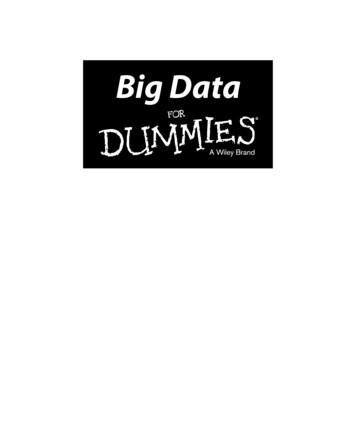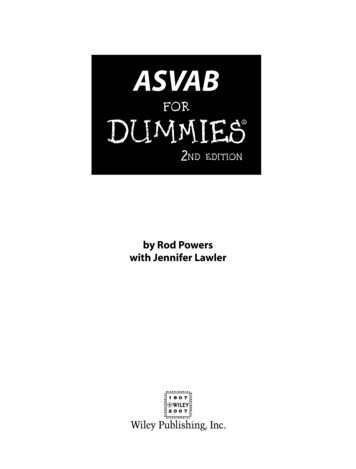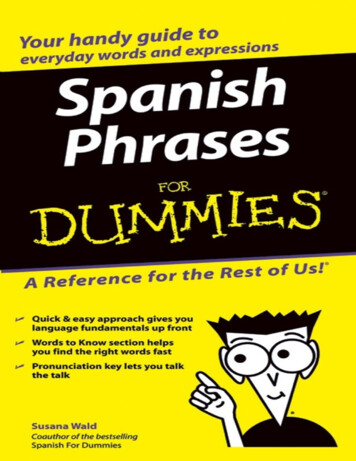
Transcription
RE SPECIAL EDITIONby Steve Piper, CISSPThese materials are the copyright of John Wiley & Sons, Inc. and anydissemination, distribution, or unauthorized use is strictly prohibited.
Security Configuration Management For Dummies , Tripwire Special EditionPublished byJohn Wiley & Sons, Inc.111 River St.Hoboken, NJ 07030-5774www.wiley.comCopyright 2013 by John Wiley & Sons, Inc., Hoboken, New JerseyPublished by John Wiley & Sons, Inc., Hoboken, New JerseyNo part of this publication may be reproduced, stored in a retrieval system or transmitted in anyform or by any means, electronic, mechanical, photocopying, recording, scanning or otherwise,except as permitted under Sections 107 or 108 of the 1976 United States Copyright Act, without theprior written permission of the Publisher. Requests to the Publisher for permission should beaddressed to the Permissions Department, John Wiley & Sons, Inc., 111 River Street, Hoboken, NJ07030, (201) 748-6011, fax (201) 748-6008, or online at http://www.wiley.com/go/permissions.Trademarks: Wiley, the Wiley logo, For Dummies, the Dummies Man logo, A Reference for the Restof Us!, The Dummies Way, Dummies.com, Making Everything Easier, and related trade dress aretrademarks or registered trademarks of John Wiley & Sons, Inc. and/or its affiliates in the UnitedStates and other countries, and may not be used without written permission. Tripwire and theTripwire logo are trademarks or registered trademarks of Tripwire, Inc. All other trademarks are theproperty of their respective owners. John Wiley & Sons, Inc., is not associated with any product orvendor mentioned in this book.LIMIT OF LIABILITY/DISCLAIMER OF WARRANTY: THE PUBLISHER AND THE AUTHOR MAKE NOREPRESENTATIONS OR WARRANTIES WITH RESPECT TO THE ACCURACY OR COMPLETENESSOF THE CONTENTS OF THIS WORK AND SPECIFICALLY DISCLAIM ALL WARRANTIES, INCLUDINGWITHOUT LIMITATION WARRANTIES OF FITNESS FOR A PARTICULAR PURPOSE. NO WARRANTYMAY BE CREATED OR EXTENDED BY SALES OR PROMOTIONAL MATERIALS. THE ADVICE ANDSTRATEGIES CONTAINED HEREIN MAY NOT BE SUITABLE FOR EVERY SITUATION. THIS WORKIS SOLD WITH THE UNDERSTANDING THAT THE PUBLISHER IS NOT ENGAGED IN RENDERINGLEGAL, ACCOUNTING, OR OTHER PROFESSIONAL SERVICES. IF PROFESSIONAL ASSISTANCE ISREQUIRED, THE SERVICES OF A COMPETENT PROFESSIONAL PERSON SHOULD BE SOUGHT.NEITHER THE PUBLISHER NOR THE AUTHOR SHALL BE LIABLE FOR DAMAGES ARISINGHEREFROM. THE FACT THAT AN ORGANIZATION OR WEBSITE IS REFERRED TO IN THIS WORKAS A CITATION AND/OR A POTENTIAL SOURCE OF FURTHER INFORMATION DOES NOT MEANTHAT THE AUTHOR OR THE PUBLISHER ENDORSES THE INFORMATION THE ORGANIZATIONOR WEBSITE MAY PROVIDE OR RECOMMENDATIONS IT MAY MAKE. FURTHER, READERSSHOULD BE AWARE THAT INTERNET WEBSITES LISTED IN THIS WORK MAY HAVE CHANGEDOR DISAPPEARED BETWEEN WHEN THIS WORK WAS WRITTEN AND WHEN IT IS READ.For general information on our other products and services, or how to create a custom For Dummiesbook for your business or organization, please contact our Business Development Departmentin the U.S. at 877-409-4177, contact info@dummies.biz, or visit www.wiley.com/go/custompub.For information about licensing the For Dummies brand for products or services, contactBrandedRights&Licenses@Wiley.com.ISBN 978-1-118-54516-4 (pbk); ISBN 978-1-118-54553-9 (ebk)Manufactured in the United States of America10 9 8 7 6 5 4 3 2 1Publisher’s AcknowledgmentsSome of the people who helped bring this book to market include the following:Acquisitions, Editorial, andVertical WebsitesDevelopment Editor: Kathy SimpsonProject Editor: Jennifer BinghamEditorial Manager: Rev MengleBusiness Development Representative:Karen HattanCustom Publishing Project Specialist:Michael SullivanComposition ServicesSr. Project Coordinator: Kristie ReesLayout and Graphics: Jennifer CreaseyProofreader: Susan MoritzSpecial Help from Tripwire: Michael Thelander,Eric Stalker, Harold MetzgerBusiness DevelopmentLisa Coleman, Director, New Market and BrandDevelopmentThese materials are the copyright of John Wiley & Sons, Inc. and anydissemination, distribution, or unauthorized use is strictly prohibited.
Table of ContentsIntroduction . . . . . . . . . . . . . . . . . . . . . . . . . . . . . . . . . . . . . . 1How This Book Is Organized. 1Icons Used in This Book. 2Chapter 1: Understanding SecurityConfiguration Management . . . . . . . . . . . . . . . . . . . . . . 3What Is SCM?. 3How SCM is used. 4The anatomy of SCM. 6Identifying Ideal SCM Buyers. 8Seeing Why File Integrity Monitoring Matters. 8How FIM works. 9Why SCM fails without FIM. 10Understanding SCM Policies. 10Policy origins. 11Policy components. 11Chapter 2: Modern SCM Features . . . . . . . . . . . . . . . . . . 13Basic SCM Features. 13Policy library. 13System baselining. 14Agents. 14Periodic agentless scanning. 14Dashboards. 14Reports. 15Remediation guidance. 15Granular administrative access control. 16Advanced SCM Features. 16FIM-powered assessment . 16Asset tags. 17Policy waivers. 17Multipolicy capabilities. 17Automated remediation workflows. 17Support for distributed environments. 18Integration with third-party products. 18These materials are the copyright of John Wiley & Sons, Inc. and anydissemination, distribution, or unauthorized use is strictly prohibited.
ivSecurity Configuration Management For DummiesChapter 3: Reducing Your Network’sAttack Surface . . . . . . . . . . . . . . . . . . . . . . . . . . . . . . . . 19Differentiating Frameworks from Regulations. 19Complying with IT Security Frameworks. 20SANS 20 Critical Security Controls . 20NIST SP 800-53. 22ISO 27001. 23COBIT. 24Chapter 4: Achieving Regulatory Compliance. . . . . . . . 27Payment Card Industry Data Security Standard(PCI DSS). 28Counting the cost of PCI compliance failure. 28Using SCM to achieve PCI compliance. 29Health Insurance Portability and Accountability Act(HIPAA). 31North American Electric Reliability Corporation (NERC). 32Sarbanes-Oxley Act (SOX). 34Federal Information Security Management Act (FISMA). 35Defense Information Systems Agency (DISA). 36Chapter 5: Getting Started. . . . . . . . . . . . . . . . . . . . . . . . . 37Researching Before Purchasing. 37Scope your environment. 37Choose the hardware. 38Consider support for distributed environments. 38Deploying Your SCM Solution. 39Deploy agents. 39Configure network-device scanning. 39Optimize dashboards and reports. 40Enable third-party product integration. 40Train users. 40Chapter 6: Ten Buying Criteria for SCM . . . . . . . . . . . . . 41Expansive Policy Template Library. 41Heterogeneous Platform Support. 42FIM-Powered SCM. 42Waiver and Exception Management. 42Support for Distributed Environments. 43Comprehensive Third-Party Integration Support. 43Multipolicy Capabilities. 43Remediation Guidance and Workflows. 44Ease of Use. 44Responsive Customer Support. 44These materials are the copyright of John Wiley & Sons, Inc. and anydissemination, distribution, or unauthorized use is strictly prohibited.
IntroductionToday’s enterprises and government agencies face twoenormous challenges: minimizing network security risksand maintaining compliance with industry and/or governmentregulations. Fortunately, an information security solution isavailable to help IT organizations achieve both objectives atthe same time.Security configuration management (SCM) enables IT securityprofessionals to reduce their networks’ attack surfaces byproactively and continuously hardening the security configurations of operating systems, applications, and networkdevices. At the same time, SCM enables compliance auditorsto monitor compliance with mandated policies.If you’re in charge of securing your organization’s network,reducing its attack surface, or maintaining and proving compliance with regulations, this book is for you.How This Book Is OrganizedThis book is organized so that you don’t have to read it coverto cover, front to back. You can skip around and read just thechapters that interest you: Chapter 1, “Understanding Security ConfigurationManagement,” provides a high-level overview of SCM andits components and describes how a typical SCM solutionworks. It also defines the role of file integrity monitoring(FIM) in the context of a full-featured SCM solution. Thechapter closes by exploring typical components of SCMpolicies. Chapter 2, “Modern SCM Features,” explores the basicfeatures of today’s SCM product offerings, as well as theadvanced features available only in leading SCM solutions.This chapter discusses the importance of remediationguidance and workflows, asset tags, and policy waivers,These materials are the copyright of John Wiley & Sons, Inc. and anydissemination, distribution, or unauthorized use is strictly prohibited.
2Security Configuration Management For Dummiesand it shows you how SCM can integrate within yourexisting IT infrastructure. In Chapter 3, “Reducing Your Network’s AttackSurface,” I describe the first of two key use cases forSCM: reducing risk by hardening network assets to minimize the potential for network security breaches. In thischapter, I provide an overview of common IT securityframeworks, including SANS 20 Critical Security Controls,NIST SP 800-53, ISO 27001, and COBIT. Chapter 4, “Achieving Regulatory Compliance,” detailsthe second of two SCM use cases: achieving compliancewith industry and/or government regulations. In thischapter, I discuss how SCM is a critical part of maintaining compliance with six common regulations, includingthe Payment Card Industry Data Security Standard (PCIDSS), the Health Insurance Portability and AccountabilityAct (HIPAA), and the Sarbanes-Oxley Act (SOX). In Chapter 5, “Getting Started,” I outline the items thatyou must consider before purchasing an SCM solution.Then I discuss best practices for implementing an SCMsystem, including deploying agents, scanning networkdevices, and optimizing dashboards and reports. In Chapter 6, “Ten Buying Criteria for SCM,” I describewhat to look for — and what to avoid — when evaluatingSCM solutions.Icons Used in This BookThis book uses the following icons to indicate special content.You won’t want to forget the information in these paragraphs.These paragraphs provide practical advice that will help youcraft a better strategy, whether you’re planning a purchase orsetting up your software.Look out! When you see the Warning icon, it’s time to payattention. You won’t want to miss this important cautionaryinformation.Maybe you’re one of those highly detailed people who reallyneed to grasp all the nuts and bolts, even the most techieparts. If so, these tidbits are right up your alley.These materials are the copyright of John Wiley & Sons, Inc. and anydissemination, distribution, or unauthorized use is strictly prohibited.
Chapter 1Understanding SecurityConfiguration ManagementIn This Chapter Defining SCM Recognizing ideal SCM customers Understanding the pivotal role of file integrity monitoring Getting grounded in SCM policiesEnterprises and government agencies that must comply withindustry and/or government regulations face two enormouschallenges: continuous defense against sophisticated cyberthreats and periodic verification of regulatory compliance.Fortunately, a single solution can help IT departments meetboth challenges. I’m speaking, of course, of security configuration management — SCM for short.In this chapter, I discuss how SCM works, identify its idealbuyers and users, and review some of its key components.I also describe why a subset of SCM functionality called fileintegrity monitoring is a critical component for any successfulSCM deployment.First, though, I define SCM itself.What Is SCM?Security configuration management exists at the point whereIT security and IT operations meet. It’s a software-based solution that combines elements of vulnerability assessment,automated remediation, and configuration assessment. TheThese materials are the copyright of John Wiley & Sons, Inc. and anydissemination, distribution, or unauthorized use is strictly prohibited.
4Security Configuration Management For Dummiesgoal of SCM is to reduce security risks by ensuring that systems are properly configured — hardened — to meet internaland/or regulatory security and compliance standards.SCM combines network monitoring and endpoint protectionmethodologies to compare monitored systems against anapproved configuration baseline. Deviations from this baseline, known as test failures, can often be corrected with little tono human intervention (see Chapter 3).Security configuration management is sometimes referred toas secure configuration management. The terms are equallyacceptable, although the former is more commonly used innongovernment agencies. In this book, the SCM acronymapplies to both terms.How SCM is usedOver the past five years, SCM has evolved from a “nice-tohave” to a “must-have” solution for hardening IT systems andnetwork devices (routers, switches, and other network components) and for demonstrating compliance with regulatorystandards. Today, virtually every enterprise and governmentagency uses SCM as part of a defense-in-depth strategy (layersof IT security defenses that mitigate cyberthreats) and as ameans of verifying compliance with regulatory standards.SCM matters greatly to both IT security and IT operationsprofessionals, as you see in the following sections.SCM in IT securityFrom an IT security perspective, hardening computer systems is a fundamental step toward securing the network. The2012 Data Breach Investigations Report published by bir)analyzes 855 network breaches worldwide and provides somealarming statistics: Vulnerability: Most of the victims (79 percent) were targetsof opportunity — that is, they had exploitable weaknesses. Ease of attack: Nearly all the attacks (96 percent) wererelatively simple to carry out. Lack of security controls: Almost all the breaches (97percent) could have been prevented by simple or intermediate controls (like hardened configurations).These materials are the copyright of John Wiley & Sons, Inc. and anydissemination, distribution, or unauthorized use is strictly prohibited.
Chapter 1: Understanding Security Configuration ManagementCM to SCMThe concept of configuration management (CM) as a formal management approach dates back tothe 1950s, when the U.S. Air Forcedeveloped it as a technical discipline for hardware. CM became itsown technical discipline in the late1960s, when the U.S. Department ofDefense (DoD) developed a series ofCM-based military standards.In 2010, in the face of increasingly targeted cyberthreats, theNational Institute of Standards andTechnology (NIST) began circulating new guidance about “the needfor configuration management toprotect information and informationsystems.” This document, SpecialPublication (SP) 800-128, advocateda new method of security-focused(rather than operationally focused)management for IT configurations.SP 800-128 also coined the phrasesecurity configuration managementand defined this capability as “themanagement and control of configurations for information systemsto enable security and facilitate themanagement of information security risk.” Since then SP 800-128has become the definitive guide formanaging and mitigating the risks ofconfiguration vulnerabilities in information systems.Implementing SCM to its fullest potential clearly could haveprevented a large portion of these data breaches merely byhardening target systems before the attacks occurred.SCM in IT operationsFrom an IT operations perspective, failing to comply withindustry and/or government regulations can result not only insecurity breaches but also in costly fines for noncompliance.SCM gives organizations a clear path to achieving regulatorycompliance and makes it easy to demonstrate compliancethrough a variety of prebuilt reports.These reports are specifically constructed by the SCM vendorin a way that makes it easy for internal and external auditorsto demonstrate compliance with virtually any major industryor government regulation — at least for those aspects thatspecifically relate to SCM and FIM (see Chapter 4).These materials are the copyright of John Wiley & Sons, Inc. and anydissemination, distribution, or unauthorized use is strictly prohibited.5
6Security Configuration Management For DummiesThe anatomy of SCMTo understand how SCM works, you must first understand itscomponents. This section gives you the background you need.SCM componentsFull-fledged SCM systems have three main components: Console: The console is the central nervous system andprimary interface of any SCM solution. It serves as theprimary mechanism for scanning network devices thataren’t equipped with SCM agents (discussed later in thissection), such as routers and switches. The console alsoenables users to create custom dashboards and reports. Database: The database is the central repository for alldata aggregated and analyzed by the SCM system. It mayor may not be housed on the same physical host as theconsole. Agents: Critical to the success of any SCM deployment,SCM agents monitor the configuration state of nodes(computer systems or devices). They also monitor theintegrity of key files, as I discuss later in this chapter.Agents typically are present for all critical SCM-monitorednodes, with the exception of network devices or low-risksystems. Be sure to configure your SCM console to do agentless scans of such devices — or they may go unmonitoredby your SCM solution.Some vendors promote fully agentless SCM offerings.Although the concept of SCM without any agents may soundappealing, a system of this type provides far fewer featuresand benefits than a full SCM solution. (See Chapter 2 for adescription of basic and advanced SCM features.)SCM-monitored nodesAny good SCM system can monitor five types of nodes: File systems: These nodes include file servers; desktop andlaptop computers; and other computing devices equippedwith a Windows, Unix, or Linux operating system (OS). Databases: These physical servers and virtual machines(OS instances running in VMware or another virtualcomputing platform) are configured to host a databaseThese materials are the copyright of John Wiley & Sons, Inc. and anydissemination, distribution, or unauthorized use is strictly prohibited.
Chapter 1: Understanding Security Configuration Management7application in a client/server environment. Examplesinclude DB2, Microsoft SQL Server, Oracle, and Sybase. Directory servers: These nodes include physical serversand virtual machines that host a directory application, suchas Lightweight Directory Access Protocol (LDAP), ActiveDirectory, Sun ONE Directory Server, and Novell eDirectory. Virtual infrastructures: Nodes of this type include components of a typical virtual environment, such as virtualmachines, hypervisors, and virtual switches. Network devices: These nodes include routers, switches,intrusion prevention systems, and other rack-mountablenetwork devices.Total SCM environmentFigure 1-1 illustrates a typical SCM environment, in whichthe SCM analyst uses a web browser to connect to the SCMconsole, which in turn connects to the SCM database, whichstores configuration data aggregated from SCM-monitoreddevices. The outputs of SCM — including reporting and notification, reconciliation, and remediation — are discussed indetail in Chapter 2.Figure 1-1: SCM conceptual diagram.These materials are the copyright of John Wiley & Sons, Inc. and anydissemination, distribution, or unauthorized use is strictly prohibited.
8Security Configuration Management For DummiesIdentifying Ideal SCM BuyersThere are essentially two types of ideal SCM buyers (althougha single organization may fall into both types), as follows: Organizations with dedicated IT security teams: SCMis likely to be a good fit for commercial enterprises andgovernment agencies of this type. These organizationsunderstand that every entity is a target for cyberattacksand see SCM as critical to their defense-in-depth strategyagainst these threats. Organizations that must comply with security mandates: Various industry and government policies requirecertain organizations to secure sensitive data. Followingare a few examples of these mandates: Payment Card Industry Data Security Standard (PCIDSS) for organizations that hold credit card data Health Insurance Portability and AccountabilityAct (HIPAA) for organizations that hold or processpatient health records Sarbanes-Oxley Act (SOX) for the financial recordsof publicly held organizations North American Electric Reliability Corporation(NERC) for organizations in power production ortransmission Gramm-Leach-Bliley Act (GLBA) for banking andfinancial organizations Federal Information Security Management Act(FISMA) for government organizationsOrganizations that leverage SCM for policy compliance automatically gain the benefit of an increased security posturewhen the SCM solution is used to its fullest potential.Seeing Why File IntegrityMonitoring MattersAt the beginning of this chapter, I mention a security technology called file integrity monitoring, or FIM. Later, in “SCMThese materials are the copyright of John Wiley & Sons, Inc. and anydissemination, distribution, or unauthorized use is strictly prohibited.
Chapter 1: Understanding Security Configuration Management9components,” I allude to the need to monitor the integrity ofkey files. In this section, I explore FIM in more detail becauseyou can’t do SCM right without FIM.FIM systems are sometimes known as host intrusion detectionsystems (HIDS) or as change auditing solutions. Although eithername is acceptable, most vendors refer to this technology asFIM, so I use that term in this book.FIM is the process of validating the integrity of operatingsystem and application-software files by comparing thecurrent state of files with their known-good baselines. Bycomparing how files are with how they should be, FIM helpsmaintain overall integrity of computer systems and devices.FIM systems monitor file types such as these: OS executable files OS and application configuration files Registry settings Security settings File content File modification dates and timesLike SCM, FIM is critical to both security and compliance initiatives. In theory, an organization could deploy FIM withoutSCM but not SCM without FIM (see “Why SCM fails withoutFIM,” later in this chapter).How FIM worksThe components of a FIM solution are quite similar to those ofan SCM solution: a console, database, and agents. Instead ofmonitoring for proper security setting values, however, FIM ismonitoring files for deviations from an expected or baselinestate.SCM solutions tell you the range between acceptable or riskyconfiguration settings and where a particular setting lies withinthis range (“all ports are open” versus “only these two criticalports are open”), whereas FIM tells you that something haschanged (“this port was closed yesterday and now it’s open”).These materials are the copyright of John Wiley & Sons, Inc. and anydissemination, distribution, or unauthorized use is strictly prohibited.
10Security Configuration Management For DummiesWhy SCM fails without FIMThe purpose of SCM is to assess configuration vulnerabilitieswithin your network infrastructure that hackers could exploit.But what if a system’s OS or mission-critical configuration settings have already been weakened, either accidentally or aspart of a determined attack? How would you know?Detection is why FIM is so critical, especially in the context ofSCM. SCM helps prevent cyberattacks by creating known andtrusted states for servers and databases; FIM automaticallydetects when those states have been changed and a threatmay be present.FIM-powered SCM can be thought of as dynamic SCM, ableto continually and dynamically assess vulnerabilities as theyarise. SCM powered by external scans, on the other hand,is passive SCM and can only tell if a setting was compliantat some point in time. Because of this important difference,many SCM vendors view FIM as the irreplaceable detectionengine powering their SCM solution.If you plan to deploy FIM as a stepping stone to SCM, be sureto select a vendor that has expertise in both FIM and SCM.Migrating from FIM to SCM should be as simple as entering alicense key on your FIM management console.Some vendors promote fully agentless FIM solutions.Although some auditors may view these solutions as beinggood enough for meeting certain compliance requirements,in practice, fully agentless solutions lack the depth of agentbased solutions or of hybrid solutions that use both methods.Moreover, they don’t operate in real time — the data is onlyas current as the last active scan, which is most often performed in weekly or monthly intervals.Understanding SCM PoliciesI discuss the basic and advanced features of typical SCM offerings in the next chapter. Here, however, I want to level-set youon the concept of SCM policies — partly so that Chapter 2makes sense to you.These materials are the copyright of John Wiley & Sons, Inc. and anydissemination, distribution, or unauthorized use is strictly prohibited.
Chapter 1: Understanding Security Configuration Management11An SCM policy is a collection of standards (intended devicestates) to which monitored systems on your organization’snetwork must conform to comply with internal and/or external regulations.Policy originsYou can create both internal and external SCM policies, asfollows: Internal: You can create an internal SCM policy fromscratch, or you can select an existing policy in your SCMsolution’s policy library and then modify it. Your SCMsolution enables you to capture baselines (depictions ofall current configuration states) of your monitored nodesand then compare those baselines to an SCM policy. External: To create an externally motivated SCM policyto assess compliance with a regulatory authority (suchas PCI DSS), simply start by selecting the correspondingtemplate in your SCM’s policy library.Many users begin with broad, externally oriented policies,like those from the Center for Internet Security (CIS) and thencustomize them to create specific, internally oriented IT security policies that are unique to their organizations.Policy componentsWhether your SCM policies are sourced internally or externally, their components are the same: tests, scores, weights,and thresholds. In the following sections, I describe thesecomponents in detail.TestsA policy is made up of individual tests that describe theintended state of a specific configuration setting. It might verify,for example, whether the local administrative password on aspecific node is a minimum of eight characters long.You can collect individual te
Security Configuration Management FOR DUMmIES ‰ TRIPWIRE SPECIAL EDITION by Steve Piper, CISSP These materials are the copyright of John Wiley & Sons, Inc. and any dissemination, distribution, or unauthorized use is strictly prohibited.











